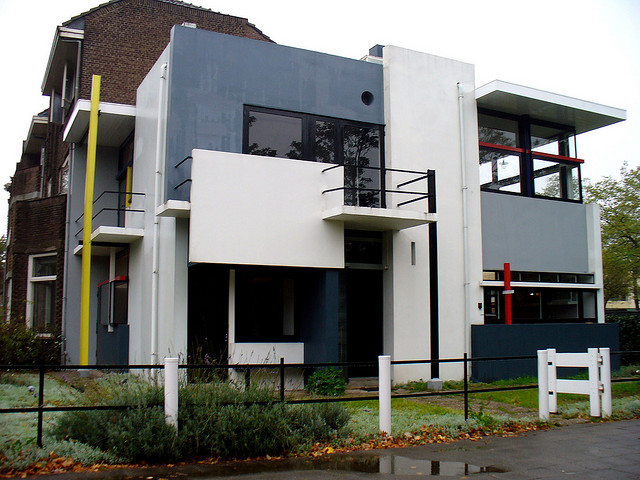Schroder-Scrader did not like the first design Rietveld made for the building. When the building was complete, it was one of the only De Stijl buildings. In 1985, Schroder died, and Bertus Mulder restored the building. In 2000, the monument was recognized as a UNESCO World Heritage Site.
Rietveld impresses modern architects by solving many issues that designers had at the time. The interior is very flexible and the planar exterior is unique to all other structures. As a De Stijl building, the Rietveld Schroder House has many primary colors throughout.
In 1917, the Dutch De Stijl movement started with Rietveld, Piet Mondrian, and J.J.P. Oud, and sought after abstraction, precision, geometry, purity, and austerity. After Mr. Schroder-Schrader died, his wife wanted a smaller, more flexible building to be built for her and her three children. Rietveld made use of many colors, such as making the front door black to prevent any dirt on the door from being visible.
The building is reenforced with steel and concrete. With a planar design, the walls are defined by three main axes. The windows also follow this format.
As a UNESCO World Heritage Site, the building is now a visitable museum. The De Stijl style can be found on the exterior and interior of the building. In 1924, the design of the building was complete.
The Rietveld Schroder House was the first house Rietveld constructed, and he implemented many of his ideas into it. Schroder wanted to feel free and flexible with movable walls. Many are intrigued about how active the building is with its residents.
In 1925, Rietveld had a studio on the ground floor. After his wife died, he moved in with Schroder until his death. In 1985, Schroder died, and gave the house to the Rietveld Schroder House Foundation to be restored.
The Rietveld Schroder House has an inside and outside unseen in architecture before. The building is two-stories tall, and does not match its neighboring buildings. The building also faces a road.
The number of rooms is dynamic, because panels in the house can be moved, slid, and rotated to create a range of combinations. The facades of the building are made of panels that are not appear disconnected. The plasticity of the building was reenforced by colors, such as white surfaces, gray shades, red window frames, black door frames, yellow rails, and blue beams.
There is little to separate the inside from the outside. Exterior elements remain constant to the interior, keeping similar colors and shapes. Even the windows can only open perpendicular to the walls of the structure. Rietveld created a marquette to display all of these aspects before completing the structure.
Rietveld intended the structure to be built of concrete. It was cheaper to make the foundation and balcony of concrete, walls of brick and plaster, and window frames, doors, and floors of wood. The building was supported with steel girders and wire mesh.
This structure is a European house. The style of the structure most resembles the International Style.









